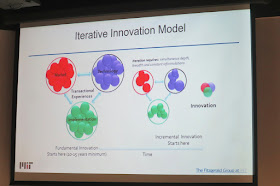I had joined
the seminar named “The Iterative Innovation Process” co-organized by HKPC and
MIT Hong Kong Innovation Node on 27th Mar 2019. I recognized Prof. Eugene A. Fitzgerald who
is the Merton C. Flemings SMA Professor of Material Engineering at the
Massachusetts Institute of Technology (MIT) and also CEO & Director of the Singapore-MIT
Alliance for Research and Technology (SMART).
He is a founding lecturer in MIT’s new Innovation and Entrepreneurship
Minor, and served on the MIT President’s Committee for the Innovation
Initiative, as well as, the President’s Committee on the Future of MIT
Education.
In the
beginning, Prof. Eugene A. Fitzgerald briefed their objectives and topics to be
discussed. He said “You cannot perform
innovation in an hour since innovation process takes years (incremental) to
decades (fundamental).” He also
introduced his book named “Inside Real Innovation” and planning for the second
edition.
The Prof. Fitzgerald used a figure “Feeling the Elephant” to explain different people had different meaning of innovation. He said it was not just invention or science or entrepreneurship. His definition of innovation is “Useful embodiments of ideas in the marketplace”. It is a basic human process that delivers value in the market place. He also added innovation efficiency was not equal to operational efficiency.
Then he
introduced the basic elements of innovation that included Market Application
(M), Technology (T) and Implementation (I). In real world, there are uncertainty in each
element that is non-linear process.
Flexible boundaries needed for M-I-T said by Prof. Eugene A. Fitzgerald. Iterative Innovation Model was demonstrated as following diagram from fundamental innovation to incremental innovation. He said that the “Aha moment” in fundamental innovation needed average time ~10 to 15 years but it create value over decades.
Finally, Prof.
Fitzgerald compared Innovation Efficiency and Operational Efficiency in the
following diagram. Operation Efficiency
is linear and Answer-Driven; where Innovation Efficiency is non-linear and
Question-Driven.
At the end, he
introduced that Singapore-MIT Alliance for Research and Technology (SMART)
could help your organization innovation through train people about innovation
process, lead innovation project and accommodating innovation process.
Hopefully,
M-I-T Iterative Innovation Process could enhance Hong Kong Innovation
Ecosystem. Before Prof. Eugene A. Fitzgerald left, I introduced Hong Kong
Society for Quality and the China original innovation method named “Extenics”
to him. I expected to bring western Innovation idea to mainland China (eastern),
and vice versa.
Reference:
Singapore-MIT
Alliance for Research and Technology (SMART) - https://smart.mit.edu/
Prof. Eugene Fitzgerald - https://smart.mit.edu/news-events/news/eugene-a-fitzgerald-appointed-smart-ceo--director-
20180709:
Experience Sharing by ASTRI on implementation of ISO 9001 for R&D Company
and visit to Smart City Innovation Centre - https://qualityalchemist.blogspot.com/2018/07/experience-sharing-by-astri-on.html
20181022:
Visit to MIT Hong Kong Innovation Node - https://qualityalchemist.blogspot.com/2018/10/visit-to-mit-hong-kong-innovation-node.html







沒有留言:
發佈留言